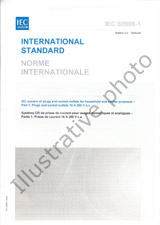We need your consent to use the individual data so that you can see information about your interests, among other things. Click "OK" to give your consent.

IEC 61910-1-ed.1.0
Medical electrical equipment - Radiation dose documentation - Part 1: Radiation dose structured reports for radiography and radioscopy
STANDARD published on 24.9.2014
The information about the standard:
Designation standards: IEC 61910-1-ed.1.0
Publication date standards: 24.9.2014
SKU: NS-413879
The number of pages: 64
Approximate weight : 192 g (0.42 lbs)
Country: International technical standard
Category: Technical standards IEC
The category - similar standards:
Annotation of standard text IEC 61910-1-ed.1.0 :
IEC 61910-1:2014 applies to radiation dose structured reports produced by X ray equipment that falls within the scope of IEC 60601-2-43:2010 or IEC 60601-2-54:2009. This document does not impose specific requirements on the accuracy of the reported or displayed data. Existing standards or regulations can have applicable requirements for accuracy and precision. This standard provides specific units and quantities and prescribes data storage formats. This document does not present any requirements on the form of display of dose information to operators or other individuals. The objective of this International Standard is to specify the minimum dataset to be used for reporting dosimetric and related information associated with the production of projection radiological images. This first edition cancels and replaces IEC/PAS 61910-1, published in 2007. It constitutes a technical revision which includes the following significant technical changes with respect to IEC/PAS 61910-1:2007: - the previously defined three conformance levels have been restructured to two; - the mapping between DICOM and IEC terms is explicitly described in an annex and is decoupled from the conformance level content requirements; - and a general update to the revised contents of the DICOM RDSR definition has occurred. LIEC 61910-1:2014 sapplique aux rapports structures sur la dose de rayonnement generes par lappareil a rayonnement X entrant dans le domaine dapplication de lIEC 60601-2-43:2010 ou de lIEC 60601-2-54:2009. Le present document nimpose aucune exigence particuliere quant a lexactitude des donnees consignees ou affichees. Les normes et reglements existants peuvent comporter des exigences applicables en matiere dexactitude et de precision. La presente norme indique les unites et grandeurs specifiques et precise des formats de stockage de donnees. Le present document ne presente aucune exigence quant a laffichage des informations sur la dose aux operateurs ou a dautres individus. La presente Norme internationale a pour objet de specifier lensemble de donnees minimal a utiliser pour consigner les informations dosimetriques et connexes associees a la production dimages radiologiques de projection. Cette premiere edition annule et remplace lIEC/PAS 61910-1, parue en 2007. Cette edition constitue une revision technique qui inclut les modifications techniques majeures suivantes par rapport a lIEC/PAS 61910-1:2007: - les trois niveaux de conformite definis precedemment ont ete restructures en deux niveaux; - la correspondance entre les termes DICOM et IEC est decrite explicitement dans une annexe et est dissociee des exigences relatives au contenu des niveaux de conformite; et le contenu revise de la definition du RDSR selon la DICOM a ete mis a jour de maniere generale.
We recommend:
Technical standards updating
Do you want to make sure you use only the valid technical standards?
We can offer you a solution which will provide you a monthly overview concerning the updating of standards which you use.
Would you like to know more? Look at this page.



 Cookies
Cookies
